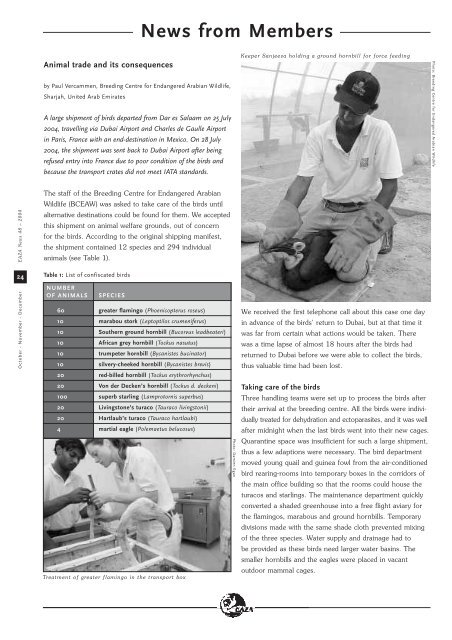EAZA NEWS 48 - European Association of Zoos and Aquaria
EAZA NEWS 48 - European Association of Zoos and Aquaria
EAZA NEWS 48 - European Association of Zoos and Aquaria
You also want an ePaper? Increase the reach of your titles
YUMPU automatically turns print PDFs into web optimized ePapers that Google loves.
<strong>EAZA</strong> News <strong>48</strong> – 2004<br />
24<br />
October - November - December<br />
Animal trade <strong>and</strong> its consequences<br />
by Paul Vercammen, Breeding Centre for Endangered Arabian Wildlife,<br />
Sharjah, United Arab Emirates<br />
A large shipment <strong>of</strong> birds departed from Dar es Salaam on 25 July<br />
2004, travelling via Dubai Airport <strong>and</strong> Charles de Gaulle Airport<br />
in Paris, France with an end-destination in Mexico. On 28 July<br />
2004, the shipment was sent back to Dubai Airport after being<br />
refused entry into France due to poor condition <strong>of</strong> the birds <strong>and</strong><br />
because the transport crates did not meet IATA st<strong>and</strong>ards.<br />
The staff <strong>of</strong> the Breeding Centre for Endangered Arabian<br />
Wildlife (BCEAW) was asked to take care <strong>of</strong> the birds until<br />
alternative destinations could be found for them. We accepted<br />
this shipment on animal welfare grounds, out <strong>of</strong> concern<br />
for the birds. According to the original shipping manifest,<br />
the shipment contained 12 species <strong>and</strong> 294 individual<br />
animals (see Table 1).<br />
Table 1: List <strong>of</strong> confiscated birds<br />
NUMBER<br />
OF ANIMALS<br />
60<br />
10<br />
10<br />
10<br />
10<br />
10<br />
20<br />
20<br />
100<br />
20<br />
20<br />
4<br />
SPECIES<br />
greater flamingo (Phoenicopterus roseus)<br />
marabou stork (Leptoptilos crumeniferus)<br />
Southern ground hornbill (Bucorvus leadbeateri)<br />
African grey hornbill (Tockus nasutus)<br />
trumpeter hornbill (Bycanistes bucinator)<br />
silvery-cheeked hornbill (Bycanistes brevis)<br />
red-billed hornbill (Tockus erythrorhynchus)<br />
Von der Decken’s hornbill (Tockus d. deckeni)<br />
superb starling (Lamprotornis superbus)<br />
Livingstone’s turaco (Tauraco livingstonii)<br />
Hartlaub’s turaco (Tauraco hartlaubi)<br />
martial eagle (Polemaetus belucosus)<br />
Treatment <strong>of</strong> greater flamingo in the transport box<br />
News from Members<br />
Photo: Damien Egan<br />
Keeper Sanjeeva holding a ground hornbill for force feeding<br />
We received the first telephone call about this case one day<br />
in advance <strong>of</strong> the birds’ return to Dubai, but at that time it<br />
was far from certain what actions would be taken. There<br />
was a time lapse <strong>of</strong> almost 18 hours after the birds had<br />
returned to Dubai before we were able to collect the birds,<br />
thus valuable time had been lost.<br />
Taking care <strong>of</strong> the birds<br />
Three h<strong>and</strong>ling teams were set up to process the birds after<br />
their arrival at the breeding centre. All the birds were individually<br />
treated for dehydration <strong>and</strong> ectoparasites, <strong>and</strong> it was well<br />
after midnight when the last birds went into their new cages.<br />
Quarantine space was insufficient for such a large shipment,<br />
thus a few adaptions were necessary. The bird department<br />
moved young quail <strong>and</strong> guinea fowl from the air-conditioned<br />
bird rearing-rooms into temporary boxes in the corridors <strong>of</strong><br />
the main <strong>of</strong>fice building so that the rooms could house the<br />
turacos <strong>and</strong> starlings. The maintenance department quickly<br />
converted a shaded greenhouse into a free flight aviary for<br />
the flamingos, marabous <strong>and</strong> ground hornbills. Temporary<br />
divisions made with the same shade cloth prevented mixing<br />
<strong>of</strong> the three species. Water supply <strong>and</strong> drainage had to<br />
be provided as these birds need larger water basins. The<br />
smaller hornbills <strong>and</strong> the eagles were placed in vacant<br />
outdoor mammal cages.<br />
Photo: Breeding Centre for Endangered Arabian Wildlife
















